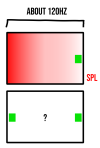- Joined
- Dec 25, 2023
- Messages
- 593
- Likes
- 626
I have a specific 30Hz room mode that completely eliminates that frequency where the subwoofer is (and where I'm listening), and I believe this is due to the waves bouncing off the front wall, then the back wall, then canceling out the negative amplitude the subwoofer has reached by the time it gets back. I've also read how two subwoofers on each side of a room can help with modes, but I'm not sure if it would help in this case, either if both were in phase, one inverted, or one slightly delayed. Would it here? I would love to be able to hear low-bass without standing on the other side.



